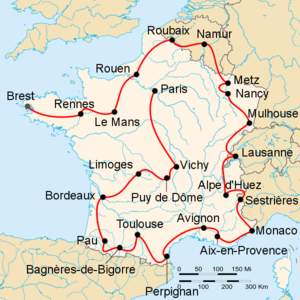1952 Tour de France

Route of the 1952 Tour de France
Followed clockwise, starting in Brest and finishing in Paris |
|||||||||||||||||||||||||
| Race details | |||||||||||||||||||||||||
|---|---|---|---|---|---|---|---|---|---|---|---|---|---|---|---|---|---|---|---|---|---|---|---|---|---|
| Dates | 25 June – 19 July | ||||||||||||||||||||||||
| Stages | 23 | ||||||||||||||||||||||||
| Distance | 4,898 km (3,043 mi) | ||||||||||||||||||||||||
| Winning time | 151h 57' 20" | ||||||||||||||||||||||||
| Results | |||||||||||||||||||||||||
|
|||||||||||||||||||||||||
| Winner |
|
(Italy) | |
| Second |
|
(Belgium) | |
| Third |
|
(Spain) | |
|
|
|||
| Mountains |
|
(Italy) | |
| Team | Italy | ||
The 1952 Tour de France was the 39th edition of the Tour de France, taking place from 25 June to 19 July. It was composed of 23 stages over 4,898 km (3,043 mi). Newly introduced were the arrivals on mountain peaks.
The race was won by Italian Fausto Coppi. Coppi dominated the race, winning five stages and the mountains classification, and was a member of the winning Italian team. His dominance was so large that the Tour organisation had to double the prize money for second place to make the race interesting. At the end, Coppi had a margin of almost half an hour over the second-ranked cyclist, such a margin has never been achieved again.
As was the custom since the 1930 Tour de France, the 1952 Tour de France was contested by national and regional teams. The three major cycling countries in 1952, Italy, Belgium and France, each sent a team of 12 cyclists. Other countries sent teams of 8 cyclists: Switzerland, Luxembourg (together with Australia), Netherlands and Spain. The French regional cyclists were divided into four teams of 12 cyclists: Paris, North East–Center, South East and West–South West. The last team of eight cyclists was made up out of cyclists from the French North African colonies. In the end, Luxembourg only sent 6 cyclists, so altogether this made 122 cyclists. There were 57 French (of which 6 were Algerian), 13 Italian, 12 Belgian, 8 Dutch, 8 Spanish, 8 Swiss, 5 Luxembourgian and 1 Australian cyclists.
The teams entering the race were:
The winners of the last two editions, Swiss cyclists Hugo Koblet and Ferdinand Kübler, were injured and did not enter the race, nor did French cyclist Louison Bobet. On the last press conference before the race, Jacques Goddet conducted a poll amongst journalists to see who they considered the favourite. Coppi received 29 votes in that poll, followed by Géminiani and Bartali, both with 26 votes.
The final stage was from Vichy, the capital of Vichy France in the Second World War, to Paris. Vichy had never before been visited, and the distance from Vichy to Paris was significantly longer than the other stages. A newspaper described it as linking the two cities together. The stop in Vichy was successful, with a new record of 150.000 live spectators. An innovation was the stage arrivals on mountain peaks. This happened three times in 1952, on stages 10, 11 and 21. There were two rest days, in Alpe d'Huez and Toulouse.
...
Wikipedia
